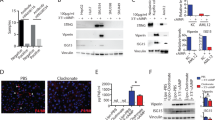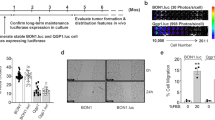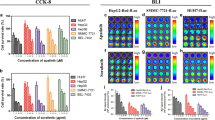Abstract
Colorectal cancer can metastasize to the liver, but remain liver confined for years. A critical step in developing treatments for intrahepatic cancer involves assessment in an orthotopic intrahepatic model. The purpose of this study was to develop a noninvasive intrahepatic tumor model to study the efficacy of 5-flucytosine/yeast cytosine deaminase (5FC/yCD)-based gene therapy for liver tumors. Luciferase expressing human colorectal carcinoma (HT-29luc) cells were generated by retroviral infection and implanted in the left liver lobe of nude mice. The bioluminescence was measured every week for a period of 1 month, then animals were killed and tumors were measured by calipers. After we found a correlation between photon counts and tumor size, animals were implanted with tumors composed of either 0%, 10%, or 100% yCD/HT-29luc cells, and treated with 5FC. Tumor bioluminescence was measured during treatment and tumor histology examined at the time of death. We found that 5FC caused significant regression of yCD expressing tumors. Furthermore, visible tumors at the time of death, which emitted little bioluminescence, contained little or no viable tumor. We then developed an adenoviral vector for yCD. Intraperitoneal administration of adenovirus containing yCD led to the production of yCD enzyme within intrahepatic tumors. These results suggest that (1) intrahepatic cancer responds to 5FC when cells express yCD; (2) the luciferin–luciferase system permits non-invasive real time imaging of viable intrahepatic cancer; and (3) this system can be used to carry out gene therapy experiments using yCD adenovirus.
This is a preview of subscription content, access via your institution
Access options
Subscribe to this journal
Receive 12 print issues and online access
$259.00 per year
only $21.58 per issue
Buy this article
- Purchase on Springer Link
- Instant access to full article PDF
Prices may be subject to local taxes which are calculated during checkout







Similar content being viewed by others
References
Austin EA, Huber BE . A first step in the development of gene therapy for colorectal carcinoma: cloning, sequencing, and expression of Escherichia coli cytosine deaminase Mol Pharmacol 1993 43: 380–387
Ohwada A, Hirschowitz EA, Crystal RG . Regional delivery of an adenovirus vector containing the Escherichia coli cytosine deaminase gene to provide local activation of 5-fluorocytosine to suppress the growth of colon carcinoma metastatic to liver Hum Gene Ther 1996 7: 1567–1576
Lawrence TS et al. Preferential cytotoxicity of cells transduced with cytosine deaminase compared to bystander cells after treatment with 5-flucytosine Cancer Res 1998 58: 2588–2593
Hamstra DA et al. Enzyme/prodrug therapy for head and neck cancer using a catalytically superior cytosine deaminase Hum Gene Ther 1999 10: 1993–2003
Kievit E et al. Superiority of yeast over bacterial cytosine deaminase for enzyme/prodrug gene therapy in colon cancer xenografts Cancer Res 1999 59: 1417–1421
Block A et al. Gene therapy of metastatic colon carcinoma: regression of multiple hepatic metastases by adenoviral expression of bacterial cytosine deaminase Cancer Gene Ther 2000 7: 438–445
Mullen CA, Kilstrup M, Blaese RM . Transfer of the bacterial gene for cytosine deaminase to mammalian cells confers lethal sensitivity to 5-fluorocytosine: a negative selection system Proc Natl Acad Sci USA 1992 89: 33–37
Rogulski KR et al. Pronounced antitumor effects and tumor radiosensitization of double suicide gene therapy Clin Cancer Res 1997 3: 2081–2088
Kievit E et al. Yeast cytosine deaminase improves radiosensitization and bystander effect by 5-fluorocytosine of human colorectal cancer xenografts Cancer Res 2000 60: 6649–6655
Fidler IJ . Orthotopic implantation of human colon carcinomas into nude mice provides a valuable model for the biology and therapy of metastasis Cancer Metast Rev 1991 10: 229–243
Fidler IJ . Orthotopic implantation of human colon carcinomas into nude mice provides a valuable model for the biology and therapy of metastasis Nyati MK et al. Selective expression of yeast cytosine deaminase under a cea promoter/enhancer. Cancer Res 2002 (in press).
Hirschowitz EA et al. In vivo adenovirus-mediated gene transfer of the Escherichia coli cytosine deaminase gene to human colon carcinoma-derived tumors induces chemosensitivity to 5-fluorocytosine Hum Gene Ther 1995 6: 1055–1063
Topf N, Worgall S, Hackett NR, Crystal RG . Regional ‘pro-drug’ gene therapy: intravenous administration of an adenoviral vector expressing the E. coli cytosine deaminase gene and systemic administration of 5-fluorocytosine suppresses growth of hepatic metastasis of colon carcinoma Gene Therapy 1998 5: 507–513
Diasio RB, Lakings DE, Bennett JE . Evidence for conversion of 5-fluorocytosine to 5-fluorouracil in humans: possible factor in 5-fluorocytosine clinical toxicity Antimicrob Agents Chemother 1978 14: 903–908
Harris BE, Manning BW, Federle TW, Diasio RB . Conversion of 5-fluorocytosine to 5-fluorouracil by human intestinal microflora Antimicrob Agents Chemother 1986 29: 44–48
Yang M et al. Whole-body optical imaging of green fluorescent protein-expressing tumors and metastases Proc Natl Acad Sci USA 2000 97: 1206–1211
Contag CH, Jenkins D, Contag PR, Negrin RS . Use of reporter genes for optical measurements of neoplastic disease in vivo Neoplasia 2000 2: 41–52
Rehemtulla A et al. Rapid and quantitative assessment of cancer treatment response using in vivo bioluminescence imaging Neoplasia 2000 2: 491–495
Stegman LD et al. Diffusion MRI detects early events in the response of a glioma model to the yeast cytosine deaminase gene therapy strategy Gene Therapy 2000 7: 1005–1010
Lawrence TS et al. The effect of single versus double-strand substitution on halogenated pyrimidine-induced radiosensitization and DNA strand breakage in human tumor cells Radiat Res 1990 123: 192–198
Acknowledgements
We thank Mats Ljungman for helpful suggestions, Mary Davis and Maureen Johnson for technical assistance, Amy Pace for her help in making figures for this paper and Eric Duckers, University of Michigan for adenovirus generation. This work was supported by grants from the NIH (CA80145 and CA 83099) and a Munn Research Award from the University of Michigan Cancer Center.
Author information
Authors and Affiliations
Rights and permissions
About this article
Cite this article
Nyati, M., Symon, Z., Kievit, E. et al. The potential of 5-fluorocytosine/cytosine deaminase enzyme prodrug gene therapy in an intrahepatic colon cancer model. Gene Ther 9, 844–849 (2002). https://doi.org/10.1038/sj.gt.3301706
Received:
Accepted:
Published:
Issue Date:
DOI: https://doi.org/10.1038/sj.gt.3301706
Keywords
This article is cited by
-
A novel Cd(II) compound of flucytosine: synthesis, structure, and optical properties
Transition Metal Chemistry (2023)
-
Detecting and monitoring tumors in orthotopic colorectal liver metastatic animal models with high-resolution ultrasound
Clinical & Experimental Metastasis (2022)
-
Stable knockdown of CREB, HIF-1 and HIF-2 by replication-competent retroviruses abrogates the responses to hypoxia in hepatocellular carcinoma
Cancer Gene Therapy (2017)
-
Targeted antitumor prodrug therapy using CNGRC-yCD fusion protein in combination with 5-fluorocytosine
Journal of Biomedical Science (2016)
-
Vessel co-option mediates resistance to anti-angiogenic therapy in liver metastases
Nature Medicine (2016)



